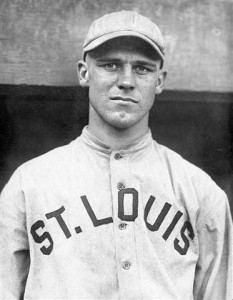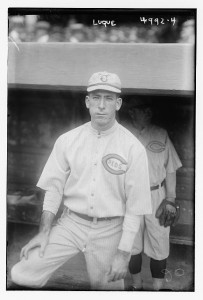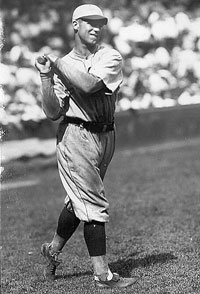Historical Hitter October 3 1920: George Sisler

October 3 has been the date for epic contests between the Giants and Dodgers. While the current teams date from the 1889 World Series, New York and Brooklyn based teams have been playing against each other from the early days of baseball. While they are many more critical games in this rivalry, here are five games played on October 3.
1993 – Dodgers win 12-1; Giants knocked out of the Playoffs
1962 – Giants rallied for four runs in the ninth inning; Winning the Pennant
1951 – Bobby Thomson; Giants win the Pennant!
1916 – Robins top Giants 8-6; Brooklyn clinches the pennant.
1861 – NY Mutuals beat the Brooklyn Atlantics
 As we are in the midst of Hispanic Heritage month, in 1919 Cuban born Dolf Luque, known as “The Pride of Havana,” became the first Hispanic player to appear in a World Series game. He pitched at total of five shutout innings in this tainted series. On October 7, 1933 with the Giants, he would become the first Cuban to win a World Series game, and to get a hit, a single to center. He pitched in relief in the Series clincher winning game 5, holding the Senators to just two hits and no runs.
As we are in the midst of Hispanic Heritage month, in 1919 Cuban born Dolf Luque, known as “The Pride of Havana,” became the first Hispanic player to appear in a World Series game. He pitched at total of five shutout innings in this tainted series. On October 7, 1933 with the Giants, he would become the first Cuban to win a World Series game, and to get a hit, a single to center. He pitched in relief in the Series clincher winning game 5, holding the Senators to just two hits and no runs.
The batting hero of the day from 1920 is George Sisler, on this day as his St. Louis Browns defeated the White Sox handily and with ease, 16-7. On this, the last day of the season, he went 3 for 5 with 3 runs score, 2 RBI, a double and 3 stolen bases. Sisler’s hitting barrage ended his season total at hit total of 257.
And just to finish the game in style, Sisler pitched the 9th inning, gave up no hits and struck out two.
 He was known by the nickname ‘Gorgeous George’, and often cited to be one of the best hitters in the game. Born in Ohio, he attended the University of Michigan playing Branch Rickey. He was first brought to the majors as a left-handed pitcher, but hitting talents were too good for every four days. He being a natural lefty switched to first base became a stalwart for 15 seasons. Sisler is noted for after making a ground ball stop and then by instinct tossing it to the pitcher, the realizing the pitcher was not racing to the bag, so he caught his own throw and then beat the runner to first – perhaps an assist and putout on the same play.
He was known by the nickname ‘Gorgeous George’, and often cited to be one of the best hitters in the game. Born in Ohio, he attended the University of Michigan playing Branch Rickey. He was first brought to the majors as a left-handed pitcher, but hitting talents were too good for every four days. He being a natural lefty switched to first base became a stalwart for 15 seasons. Sisler is noted for after making a ground ball stop and then by instinct tossing it to the pitcher, the realizing the pitcher was not racing to the bag, so he caught his own throw and then beat the runner to first – perhaps an assist and putout on the same play.
Sisler hit .400 twice, once in 1920 with a .407 and again in ’22 with an amazing .420 average. The 1920 year he led the American League in games played (154) at bats, hits, average and total bases. He led the Brownies with 19 home runs and tied the RBI total with 122. Finally he was second with 42 stolen bases. Sisler had a 25-game hitting streak and even hit for the cycle during the 20 season, remarkably and sadly, the Browns had no pitching and finished 4th, going 76-77 some 21.5 games out of first.
The reason Sisler remains a relative unknown rests with him playing for poor teams, (the highest finish was second by the 1922 Browns) and being eclipsed by the Babe’s then record 59 home runs and by the loud personality of Ty Cobb and the heroism of Lou Gerhig. Adding to his lack publicity was Sisler’s modest personality which was described as:
“modest, almost to a point of bashfulness, as far from egotism as a blushing debutante… Shift the conversation to Sisler himself and he becomes a clam.”
In a recent book about Sisler by Rich Huhn, Sisler is described a “Legend without a Legend.” Branch Rickey defined Sisler as one of Baseball immortals albeit a quiet one.
“…his brief yet effective words of instruction, and, above all, his marvelous aptitude mad him a nonpareil.”
Rickey also noted that Sisler was almost slump free due to his inner strength and confidence noting that:
“He changes nothing and does not recognize the word ‘slump.” He has had immunity from that malady for years.”
At the height of his career, Sisler was struck with a severe attack of sinusitis which caused double vision and lead to him missing the entire 1923 season. Sisler’s response to the illness and his determination to return to play never waved.
“I planned to get back in uniform for 1924. I just had to meet a ball with a good swing again, and then run. The doctors all said I’d never play again, but when you’re fighting for something that actually keeps you alive – well, the human will is all you need.”
 He did return to the Browns in 1924 and played until 1927, but not at the same level. But that is a relative term, he played 600 games, churned out 797 hits, a resultant batting average of .317 and a mere mortal OPS+ of 97. He was not known as a power hitter but a noted triples and singles hitter which hurts his OPS numbers.
He did return to the Browns in 1924 and played until 1927, but not at the same level. But that is a relative term, he played 600 games, churned out 797 hits, a resultant batting average of .317 and a mere mortal OPS+ of 97. He was not known as a power hitter but a noted triples and singles hitter which hurts his OPS numbers.
Sisler was sold to the Senators in 1928 who in turn sold him to the Boston Braves. Here in the forgotten corner of Boston, Sisler did well, playing in 388 games he had 505 hits but only 9 home runs and a .326 average and OPS+ of 100. When he hung up his spikes in 1930, he amassed 2812 hits that produced a Hall of Fame average of .340. Ty Cobb has been famously quoted describing George Sisler as “the nearest thing to a perfect ballplayer.”
Elected to the Hall of Fame in 1939, his plaque has graced the walls of the Hall since it first opened its doors. In describing his batting philosophy the Hall web site posted that Sisler pitching skills and getting players out mindset made him a better hitter.
“I used to stand on the mound myself, study the batter and wonder how I could fool him,” he said. “Now when I am at the plate, I can the more easily place myself in the pitcher’s position and figure what is passing through his mind.”
He followed Branch Rickey first to Brooklyn and then Pittsburgh as roving hitting coach, player scout, and mentor. Sisler assisted in bringing Jackie Robinson to the majors, and then helped develop the Hall of Fame careers of Bill Mazeroski and Roberto Clemente Willie Stargel, and countless other players.
Sisler’s 257 hits lasted the rest of the 20th century and until 2004 when Irchio Suzuki topped Sisler’s American League record with a total of 262 hits, but as with Roger Maris’ record Suzuki played a 162 game schedule, and he did not break the record on his 154th game. Nevertheless, Ichiro was very graceful and respectful, by famous visiting Sisler’s gravesite during the 2009 All Star Game in St. Louis.
His two sons also were involved in the game. David Sisler, a Princeton graduate, pitched or threw to some success with the poor Red Sox teams of the 50’s-60’s. He was noted for being more successful outside after baseball as a financial planner. He often joked that his claim to fame with Senators was giving up home run number 28 of 61 to Roger Maris. The other son, Dick Sisler, managed the Reds and under Joe Torre was a coach with woeful ‘79-‘80 Mets. These Mets rivaled the Browns and Braves during the later years of George Sislers’ career, finishing last and then next to last with a cumulative record of combined 130-194.
[divider]
Sources:
Portrait image: http://www.i70baseball.com/2010/11/14/the-cardinals-in-time-branch-rickey-makes-the-jump/george-sisler/
Baseball-reference.com
Baseball-alamanac.com
Rickey, Branch and Riger Robert, “The American Diamond: A Documentary of the Game of Baseball.” Simon and Schuster, 1965: New York
http://en.wikipedia.org/wiki/Dolf_Luque
SABR BioProject of Dave Sisler by Rick Huhn, http://sabr.org/bioproj/ person/ 80573 1ed
